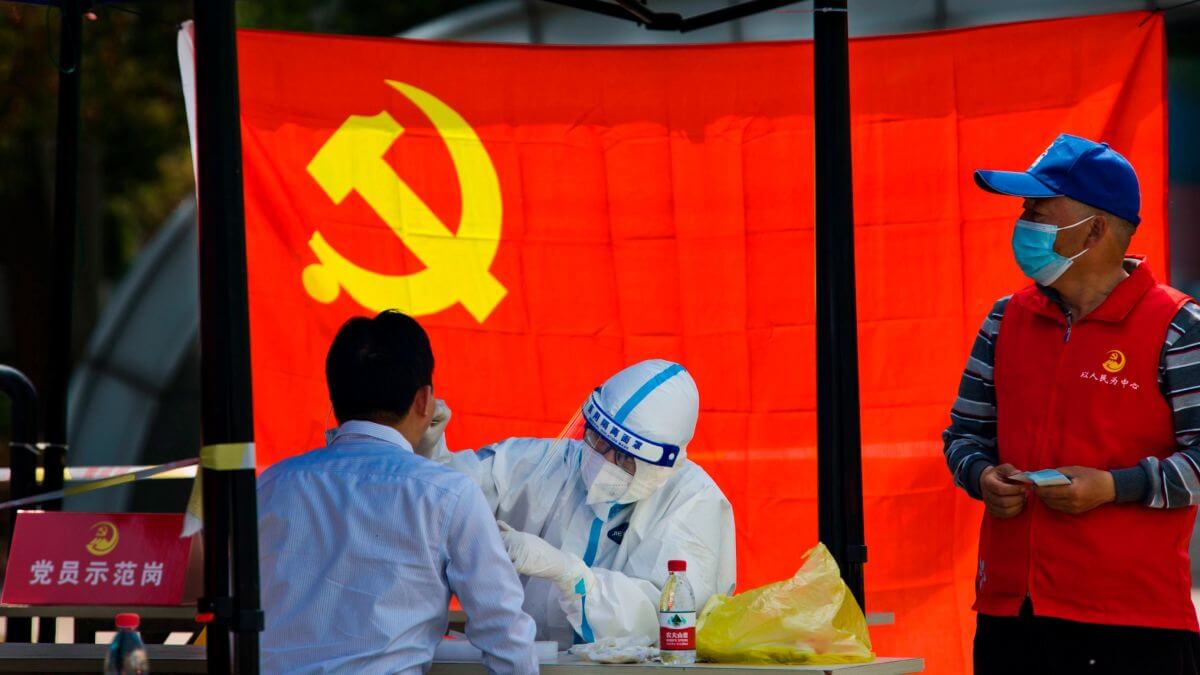Shanghai recorded 51 COVID-19 deaths on Sunday, up from 39 the day before, despite the fact that stringent lockdown measures have been in place for over four weeks now. In fact, the city has recorded a total of 138 deaths since April 17.
As part of the latest measures to control the virus, city authorities have erected fences outside residential buildings to enforce quarantine guidelines. This has sparked a fresh public outcry, as the city’s 25 million population has been forced indoors. Social media was also inundated with images of workers in white hazmat suits sealing the entrances of housing complexes and closing off entire streets with green wire fencing about two metres tall, prompting questions and complaints from residents.
Children going to school in Shanghai, China. Zero Covid strategy. Welcome to a dystopian nightmare.pic.twitter.com/QNBVnpq8CL
— James Melville (@JamesMelville) April 20, 2022
Shanghai Covid Stories: Barriers are being installed all over the city. Meanwhile their purpose hasn't been fully explained.
— chris pc (@chris__pc) April 24, 2022
A thread. pic.twitter.com/Vhnojz2cOR
“This is so disrespectful of the rights of the people inside, using metal barriers to enclose them like domestic animals,” said one user on social media platform Weibo. “Isn’t this a fire hazard?” asked another user. One video showed residents shouting from balconies at workers trying to set up fencing, while other videos showed people trying to pull down the fences.
You may think this is a scene from Zombie apocalypse movie, but this is not. In #Shanghai, people are literally being locked in prisons by CCP under COVID-zero policy. pic.twitter.com/FsjyPq5mGn
— WumaoHub (@WumaoHub) April 23, 2022
Meanwhile, in Beijing, more than a dozen buildings were put under lockdown after 22 new cases were reported in the Chaoyang district on Saturday. A school in the same district reported 10 cases on Friday and Saturday and was put under “control management” on Friday. Moreover, the city government issued a directive on Sunday that requires residents and those working in the district to undergo three COVID-19 tests this week. According to a local government briefing, the district also designated 14 smaller communities as “sealed” and 14 others as “controlled,” with varying levels of movement restrictions.
Dr Pang Xinghuo, the deputy director of the Beijing Centre for Disease Prevention and Control, warned that the risk of infection remains high and that the number of cases is expected to rise in the capital in the following days because many students and tour groups have been infected.
VIDEO: Beijing residents rush for groceries as Covid cases rise.
— AFP News Agency (@AFP) April 25, 2022
On Sunday, Beijing warned of a "grim" situation. The harsh lockdowns and mass testing of China's strict zero-Covid policy is taking a heavy toll on public morale and businesses in the world's second largest economy pic.twitter.com/qRtrd62G2X
Fearing a similar fate to Shanghai, which is experiencing severe food and water shortages, residents of Chaoyang stocked up on groceries on Sunday evening.
The Chinese government has been under increasing pressure to control the rising cases, which have hit their highest mark since the onset of the pandemic in early 2020. To this end, at least 38,000 medical workers from across China have been sent to Shanghai to help carry out medical treatment and nucleic acid testing.
Beijing’s largest district (where I live) is undergoing mass “routine PCR testing” beginning tomorrow after 40 or so Covid cases in the last week. Most residents are interpreting this as sign of imminent, total lockdown. Long lines and empty shelves at supermarkets tonight. 😷 pic.twitter.com/Vo8zmtuNBh
— Emily Feng 冯哲芸 (@EmilyZFeng) April 24, 2022
Beijing has also drawn flak for resorting to extreme measures in order to control the outbreak. In addition to a strict lockdown that has been extended indefinitely, public transportation networks have been shut down and babies and children have been separated from their parents for testing positive for the virus (though this policy was later rescinded after public outcry).
However, according to a study carried out by Peking University, China could experience a “colossal outbreak” if it took inspiration from Western governments and adopted their hybrid strategies for tackling the virus. The study argued that abandoning the Zero-Covid policies could result in more than 630,000 infections and 22,000 severe cases per day. Researchers posit that daily deaths could also possibly spike up to the hundreds or even the thousands.

